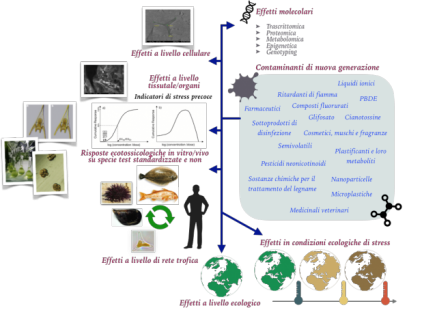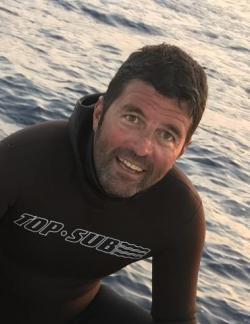The laboratory includes, as structured personnel, 1 Full Professor (Antonio Terlizzi) and 3 Associate Professors (Massimo Avian, Monia Renzi and Stanislao Bevilacqua). The research lines of the laboratory range from Ecotoxicology and Environmental Impact Assessment, to the Taxonomy and Ecophysiology of gelatinous plankton, to the definition of the life cycles of Sponges, Cnidarians, Gastropods, Echinoderms, Fish and to the quantification of the biodiversity patterns of marine organisms.
The habitats considered are those of pelagic, intertidal, subtidal, deep and submerged cave environments. The activity, on rocky bottoms, seagrasses and soft bottoms, mainly concerns the quantification of the biodiversity of meiofauna, vagile and sessile macrofauna and how the alterations of spatial and temporal distribution modes of species and populations can be used in rigorous experimental biomonitoring procedures. Some of the procedures for setting up experimental designs and data analysis most widely used in environmental impact assessment have been developed here, and in collaboration with important Italian and foreign research bodies, extended, for the first time, from the univariate context to the multivariate one. The sources of anthropogenic disturbance considered were intensive fishing, destructive fishing, sewage, port areas, mariculture facilities, offshore platforms for the extraction of hydrocarbons, human trampling.
The laboratory is also involved in evaluating the responses of populations and communities to anthropogenic impacts using an ecotoxicological approach. Through in vivo and in vitro tests, the biochemical, morpho-biometric, physiological and behavioral responses deriving from exposure to pollutants in the presence or absence of environmental perturbations are evaluated. This approach makes it possible to estimate the effects of anthropogenic pressures on sensitive species, populations, communities and the consequent impacts on the marine trophic network also in relation to future environmental scenarios (global change).
The Laboratory also actively contributes to clarifying the effects of the establishment of Marine Protected Areas (MPAs) on sessile hard substrate populations and how mitigation interventions can affect the ecosystemic responsiveness of fish and benthic hard bottom populations to perturbative events. The central point of our activity is to try to coordinate methodological rigor in the definition of experimental designs with an adequate taxonomic definition of the variables used. To this end, a substantial research activity has been focused on the applicability of synthetic indexes of biodiversity, on the importance of taxonomy in impact studies and on the taxonomic levels required in routine monitoring procedures for measuring the change in spatial patterns and temporal levels of alpha and beta levels of animal diversity.
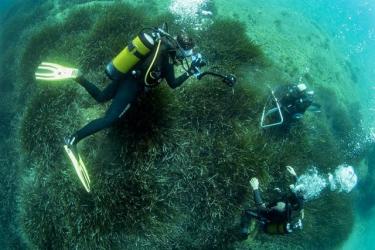
1) Impact of metabolites from invasive species on the biological and ecological systems of the Mediterranean
The invasion of alien species represents a serious threat to marine habitats throughout the Mediterranean with very serious impacts on biodiversity and the functioning of ecosystems. Invasive species also have negative effects on economic activities, such as fishing and aquaculture, and can act as vectors of diseases with impacts on wildlife and human health.
The assessment of the impact caused by invasive non-indigenous species on natural communities, habitats and ecosystems is considered a specific indicator for determining the environmental status within EU policies such as the Marine Strategy Framework Directive (MSFD).
The introduction of non-indigenous species at levels that do not negatively alter ecosystems is, in fact, one (n ° 2) of the 11 qualitative descriptors required for the achievement and maintenance of good environmental status (GES).
While the direct impacts on biodiversity have been much studied so far, very little is known about the indirect and, therefore more subtle, impacts of the molecules produced by invasive alien species on ecosystems and marine communities.
The metabolites produced by invasive alien species can, in fact, accumulate and be transferred along the food chain, with impacts on biodiversity and the functioning of ecosystems, with damage to the fishing industry and human health. In this context, a series of papers have been published focusing on the effect of secondary metabolites synthesized by the green alga Caulerpa cylindracea on the white sea bream Diplodus sargus (Terlizzi et al. 2011; Felline et al. 2012, 2014, 2017; Gorbi et al. . 2014; Ferramosca et al. 2016; De Pascali et al. 2015; Magliozzi et al. 2017).
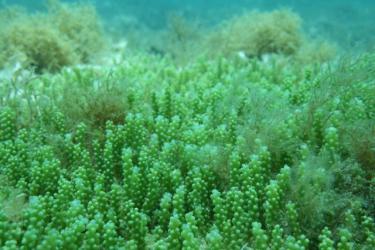
Expanse of Caulerpa cylindracea within the Protected Marine Area of Torre Guaceto (LE), Italy
Since these substances have a high biological activity, we have suggested the possible exploitation of invasive biomass to obtain natural chemicals to be used in the pharmacological / biotechnological field, making the control of invasive populations profitable, and, at the same time, reducing the impact. caused by them on natural ecosystems. One of the lines of research that the Laboratory of Zoology and Marine Biology of the University of Trieste is carrying out is therefore focused on the cause-effect relationships between specific metabolites from invasive species and the biochemical, toxicological and behavioural responses in wild fish populations.
The research that is being carried out aims to shed light on the molecular mechanisms underlying the observed changes in native biodiversity and to provide the information tools necessary for a sustainable biotechnological exploitation of invasive algae. This could help reduce the impact of invasions on ecosystems, and at the same time offer new opportunities for coastal societies in the Mediterranean, stimulating the creation of small businesses dedicated to the transformation of algal biomass.
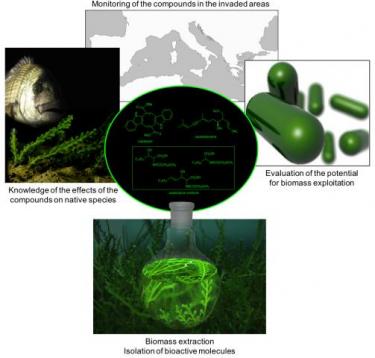
General overview of the research line on the invasive green alga Caulerpa cylindracea
2) Dynamics and effects of Micro- and Nano-plastics in marine organisms
Marine litter pollution has been defined as one of the worst threats to the health of the oceans, like global warming or ocean acidification, with potential consequences also for human health. The European Union, issuing the Marine Strategy (2008/56 / EC), pays further attention to this phenomenon on a global scale, focusing the interest of the scientific community on the most invisible fraction of the marine litter, the one represented by particles of dimensions smaller than 5 mm.
Microplastics (1 µm - 5 mm) and the even smaller fraction, nanoplastics (<1 µm), can represent a greater risk just because of their small size, making them bioavailable even at the lowest trophic levels and allowing interaction at different levels of biological organization, also penetrating cellular barriers. In addition, nanoplastics have exhibited accentuated properties and reactivity towards the medium in which they are found. This entails the possibility of interfering with the biochemistry of exposed organisms or of increasing the adsorption capacity of pollutants or pathogens already present in the water, thus facilitating their introduction into biological systems. Nanoplastics, therefore, represent a new potential vector of contamination whose mechanisms of action are still to be clarified.
Despite the growing interest of the scientific world, resulting in a significant increase in publications on the subject, many aspects relating to the dynamics of plastic toxicity are not known. For these reasons, our researchers are working on the complexity of these mechanisms by focusing attention on key species of the Mediterranean Sea and already recognized as model organisms in ecotoxicology (i.e., Vibrio fischeri, Phaeodactilum tricornutum, Paracentrotus lividus and Mytilus galloprovincialis). Furthermore, recently, the laboratory has also focused its attention on a non-endemic species of the Mediterranean, the clown fish which, in addition to being world-renowned for a well-known animated movie, has also aroused the interest of many molecular biologists and ecologists and presents itself as a possible target for contamination by plastics in tropical reef areas. Undoubtedly an innovative, stimulating and challenging line of research.

From Piccardo et al., 2020 (https://doi.org/10.1016/j.scitotenv.2020.136947)
3) Overlapping between jellyfish blooms and ichthyoplankton: biological interactions and ecological consequences
In recent years, gelatinous zooplankton (jellyfish, siphonophores, ctenophores, etc.) has been the protagonist of increasingly frequent blooms in all parts of the globe. Their abundance led to the theorization of the phenomenon "from a fish to a jellyfish ocean" (from a sea of fish to a sea of jellyfish). The causes of this phenomenon are many and vary from global warming to direct impacts related to anthropogenic activities such as overfishing.
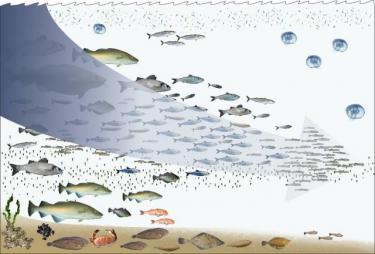
Scenery from fish to jellyfish (from Pauly et al., 1998, DOI:10.1126/science.279.5352.860)
These "jellyfish blooms" can have significant effects at different levels: ecosystem, economic, health. In particular, jellyfish, siphonophores and ctenophores can interact with the fish component of ecosystems in various ways including: 1) direct predation of fish eggs and larvae by gelatinous zooplankton, 2) competition between gelatinous zooplankton and fish larval stages for the same resources and 3) the role of gelatinous zooplankton as a potential intermediate host in the life cycles of parasites of fish species.
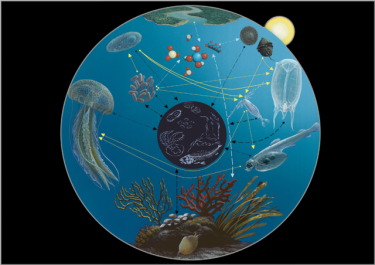
Example of a trophic network including gelatinous plankton (credit: Ferdinando Boero)
These interactions are relevant as they are thought to cause a reduction in the recruitment and abundance of the fish species involved, causing significant damage both at the ecosystem and economic level (fishing and aquaculture activities). Nevertheless, these themes have not yet been adequately studied and the gelatinous component of zooplankton is considered a secondary character in ecological mechanisms. Currently, organizations such as the EU-DG Mare and the GFCM (FAO) stimulate research and study of these issues in order to fully understand the phenomenon and obtain new tools for the management of marine ecosystems.
4) Conservation and monitoring of marine biodiversity
The anthropogenic pressure on marine ecosystems has reached unprecedented levels, undermining their stability through the deterioration of the environment, the reduction of associated biodiversity and the erosion of their potential for resilience. Understanding the effects of these alterations on the functioning of marine ecosystems, refine the methods of assessing anthropogenic impacts and implement effective and fundamental mitigation strategies to manage and maintain the structure and function of marine systems, together with the goods and services they provide. Research in these fields has so far often concerned single sources of impact, single species or single aspects of the structure of marine communities, neglecting an integrated view of the different components of diversity.
For this reason our research focuses on studying the relationships between local diversity, beta diversity and regional diversity in a transversal way, involving both taxonomic and phylogenetic and functional aspects, and on how these relationships can be exploited to improve and optimize conservation and monitoring of the state of marine systems. Our studies are aimed at defining new methodologies in the optimization of monitoring procedures based on the use of species surrogates, at improving the procedures for analyzing changes in marine biodiversity on a regional scale, and at highlighting the fundamental role of heterogeneity in the spatial and temporal distribution of species and their functional traits, in identifying the effects of anthropogenic pressure and in guiding the implementation of networks of marine protected areas.
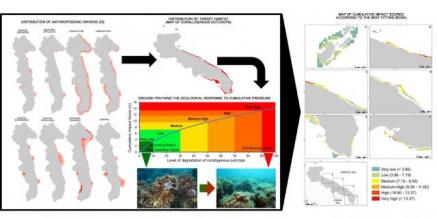
5) Ecotoxicolgy
Ecotoxicology is a relatively recent scientific discipline, born in the late 1960s. It integrates classical disciplines such as ecology, environmental toxicology and chemistry and studies the effects of pollutants on communities and ecosystems at different levels of hierarchical scale, with the aim of more effectively pursuing environmental protection. The main interest of this research area is to understand how the effects of environmental pollution can interfere with natural populations and communities. Exposure to toxic substances can produce indirect sub-lethal effects that alter the ecological fitness of individuals and modify food webs. In fact, it can alter the growth rate and the time needed to reach sexual maturity, the competitive performance for trophic resources and feeding and breeding behaviour but also the adaptation and the average survival time. At the population level, it can induce effects on interspecific interactions, on the relationship between the sexes and on the success of hatching. While at the community level it can alter interspecific interactions, competition and predation and induce greater sensitivity to parasites and pathogens.
Ecotoxicological research is based on carrying out in vivo and in vitro tests on organisms, populations and communities and considering the responses of molecular, biochemical, histological, morphological, biometric, physiological or behavioural stress indicators.
Of particular specific interest are the development and standardization of early non-destructive stress biomarkers, applicable also to protected species. Another area of great interest is the study of the effects resulting from exposure to mixtures of environmental contaminants at sub-lethal concentrations. The research group evaluates the effects of classical and new generation contaminants, such as nanoparticles, micro- and nanoplastics, cosmetic and pharmaceutical products on the marine ecosystem and evaluating the effects associated with the scenarios of variation of environmental conditions deriving from global change phenomena.
